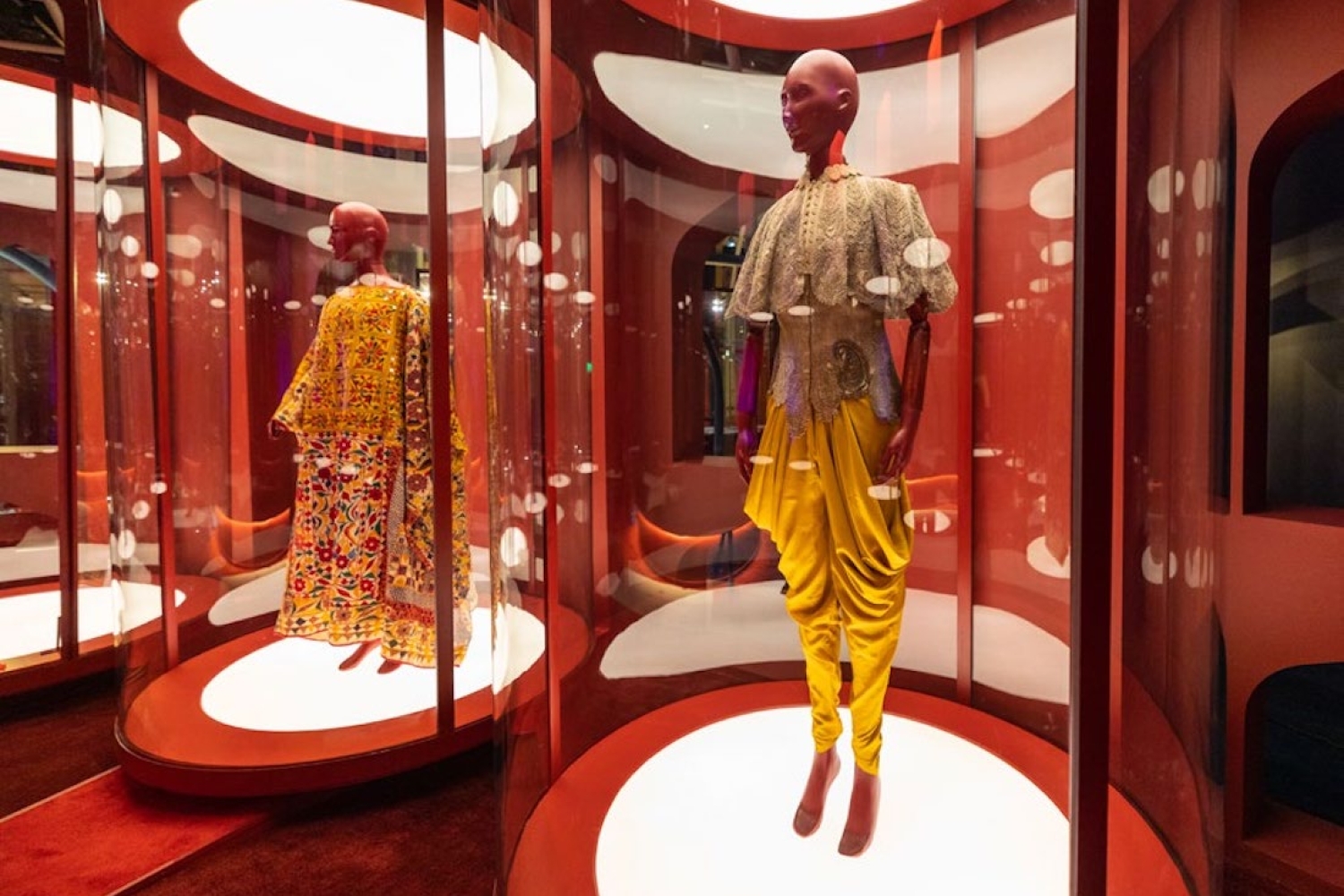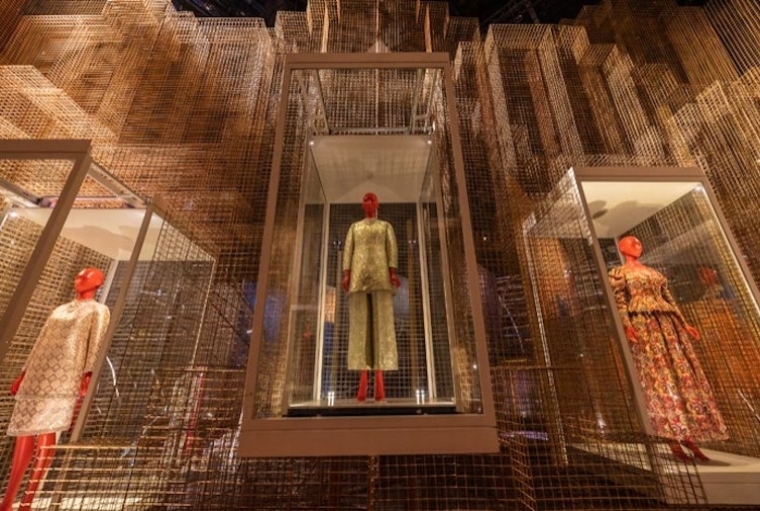

The Nita Mukesh Ambani Cultural Centre is a state-of-the-art space for the arts, with incredible capabilities to encompass a gallery, a museum, a cultural centre, a space for dialogue, all in one. The space recently opened its gate to the public with an exhibit that explores the impact that traditional Indian dress, textiles and craft have had on the international fashion sensibility since the 18th century. Ace designer and architect, Rooshad Shroff was at the helm of this exhibit, working closely with co-designer, Patrick Kinmonth and curator, Hamish Bowles.
“The Nita Mukesh Ambani Cultural Centre is a multi-disciplinary space in the sphere of the arts, and also has an adjoining space for blockbuster travelling art shows. This is where we hosted India in Fashion. The versatile space features humidity and temperature control, primarily utilised for the preservation of artefacts. With over fifty thousand square feet of open area, twelve metre-high ceilings and four intermittently placed columns to hold it all up, it is akin to a blank canvas, allowing for a great architectural intervention within the space, a vision designer Patrick Kinmonth and I shared,’ were Rooshad’s initial thoughts for the design.
We asked him to delve into it more. Excerpts below.
Do you remember how and when your romance with design began?
My father, brother and sister-in-law are all architects, and my mother is an interior designer. So I think, in a sense, my life’s perspective shifted to a constant perception of design and its varied nuances very early on. There has been this all-encompassing self-awareness of my surroundings ever since I can remember, and it was fur- ther honed by the opportunity to travel while growing up, visiting museums, exhibitions and art galleries.
You’ve experimented with interiors, architecture, furniture, products...does that mean you believe in the philosophy of integrated design?
I definitely believe in the philosophy of integrated design. It’s my job to visualise and create holistically-designed spaces, but while doing so one has to consider the sensory aspect of one’s surroundings. And that is not limited to walls and artefacts, it also comprises tactile and sense experiences. So the scale of my work is extremely varied, in that I may be designing a fifteen-thousand-square-foot residence on one hand, creating a bespoke furniture piece on the other hand, or even working on something as minuscule as a candle. As a firm, we’ve been afforded varied opportunities to explore everything from visual merchandising to weddings and exhibits, and it’s fortu- nate that we have not been pigeonholed into any particular category. We ensure that an emphasis on Indian craft paves the way forward when it comes to design across the spectrum.
Can you elaborate on your thoughts when you first approached the design for the exhibit?
In line with Mrs. Nita Ambani’s vision of showcasing the best of India to the world, Hamish Bowles, the curator of India In Fashion: The Impact Of Indian Dress and Textiles on the Fashionable Imagination, set the broader premise of the exhibit by grouping and categorising the displays in a manner similar to the book he authored by the same name. So Patrick took the lead in forming a larger narrative around Hamish’s text, and we worked on different elements of the exhibit independently before putting them together. The result was a total of ten cohesive chapters or spaces at the venue, each bringing together a particular genre of textiles, silhouettes, embroidery, and brands. YSL, Chanel and Dior, for example, each have their own independent chapter. Then there is one dedicated exclu- sively to the sari, one of the largest at the exhibit, comprising twenty-six ensembles.
In addition to the garments, each chapter or zone traces a different architectural moment in Indian history. The chintz display, for instance, is placed in a space akin to a Mughal garden. The YSL chapter is fashioned like an Indian stepwell, albeit of a more ethereal nature, with the metal cage almost made to look like it is dissolving into nothingness. The hippie trail in the Fashion Takes A Trip section is modelled after the Jantar Mantar observatory in Jaipur, and there is even a recreation of The Great Exhibition of the Works of Industry of All Nations, which Queen Victoria held in Hyde Park in 1851.
So, the zones all feature different architectural moments referencing actual spaces, and unlike a typical museum, which has a linear format dictated by its own architecture, you can look directly from one space into another. You’re not restricted to one visual; you catch glimpses of the others simultaneously, and as you make your way forward, you’re allowed a new perspective on previously visited ones as well.

What were the conversations you had with curator Hamish Bowles?
Through our conversations we came up with spaces that helped foster a narrative surrounding every display. Each chapter has quite an immersive environment — there is an integration of graphics, lighting, print and colour, particularly the colours of India, with an emphasis on strong pinks and reds. We had bespoke carpets laid in many sections, each with distinctive prints. Certain spaces have projectors running to further enhance the experience. The Mughal section holding the chintz garments, for example, has ripples such as those seen on a body of water, running on both the carpet and on the projector. We worked with electropop artist Sanaya (Ardeshir) aka Sandunes to create special sound effects and music particular to each zones as well, such as the sound of birds chirping, or Indian musical instruments. So in addition to the architectural and design aspects of the exhibit, India In Fashion is intended to provide you with a sensory experience; you’re meant to take in more than just the historic references and ensembles on display.
In today’s day and age, for what is it that you would say your practice stands?
Craft. To me, it begins and ends with craft. Our country is a treasure trove of ancient artisanal techniques, which is a truly unique advantage to us as designers. I am constantly working towards contemporising artisanry, pushing its boundaries in order to make it relevant in today’s design language.
What’s coming up next?
Large-scale architectural residences across the country, an eighty-thousand-square-foot design retail and exhibition space in Mumbai which is opening at the end of the year, and a solo furniture exhibit, also scheduled for the latter half of 2023.
This article is an all exclusive from our April EZ. To read more such articles, follow the link here.
Words Hansika Lohani
Date 22-04-2023